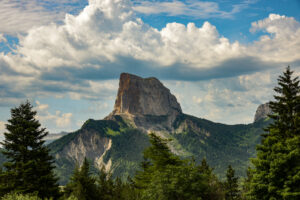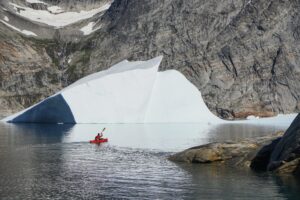Andres Marin and Clint Helander had to work hard to get up their new route, but they might have worked even harder to get safely into and out of the area.
You can find Shaft of the Abyss on the east face of Golgotha in Alaska, filed under the classic mountain axiom that a climb ends when the climbers are back to safety, not when they tag the summit.
‘Shaft of the Abyss’
Marin and Helander pegged the 1,200m route at VI AI5R M5 90° A0. The effort spanned six years for Marin and 14 for Helander. Avalanches, wind storms, and logistical boondoggles with transportation and supplies endangered the first ascensionists on several visits.

Golgotha. ‘Shaft of the Abyss’ takes the prominent central snow chute/runnel system, then meets the summit ridge slightly to the climber’s right.
Tucked away in the Revelation Mountains, Golgotha (2,694m) is a singular gem and an intimidating prospect for climbers. Marin and Helander’s route takes a prolonged, consistent weakness up the east face — a narrow snow chute in a deep corner.
Mountain resists years of FA attempts
Helander first scoped the mountain in 2008 and flew to the glacier at its base in 2010. In 2012, he and Ben Trocki tried the east face but aborted it. Instead, they took a more accessible line to the top for the mountain’s first ascent.
Climbing Shaft of the Abyss took three days on the eventual summit push, but getting there with any semblance of safety was the first challenge. Marin first visited Golgotha in 2016 with Helander. The ever-jovial Marin dubbed the small glacier at the base “the Misfit Glacier”. Soon, they’d feel distinctly out of place while standing on it.
Temperatures dramatically warmed as they stood on the ice, and they noticed rotten avalanche debris everywhere. The debris piles indicated the possibility that they might not be able to get safe before starting up the wall — but before they could begin, they got wiped out.
The avalanche scuttled their gear and destroyed their tents, and the pair crouched under a rock for a week before their bush pilot rescued them.
Return trips in 2017 and 2018 also ended without summits. A broken crampon forced them off the east face in 2017 with Leon Davis, and deep snow made the route unclimbable in 2018.
Golgotha first ascent: (relatively) smooth climbing
In March 2022, they landed under Golgotha and hit the ground running. immediately, they ferried loads to the high pass, fixed lines into the Misfit Glacier, and scoped the route from the base. Then on March 23, they left base camp and started up the couloir that leads to the chute.
Four arduous pitches on the first day led them to a bivy in a cave that they had discovered in 2017. It is one of the only options low on the route that’s safe from overhead hazards.

They continued past their previous high point the next day and climbed to a vexing ice dagger. The pitch proved to be the crux of the route. Helander led it, scrabbling up however he could — he chopped windows through curtains of ice, solving the puzzle with mixed climbing and aid techniques.
The two emerged from the lower chute. Marin, a world-class ice climber, took the sharp end for a 170m block of simul-climbing through steps of steep ice and neve.
After that, they bivvied above a long, blank slab of bare rock. Another close call happened there as Helander slid off the narrow bivy ledge while organizing the tent. His tether yanked him, plus kit and caboodle, to safety above the void.
Golgotha Summit! And a descent with a surprise
Marin and Helander negotiated another five pitches of demanding climbing to the Golgotha summit on the third morning. A long descent followed territory that Helander had explored back in 2012. Seven rappels down broken rock and snow led to a couloir.
They picked up a small cache they’d left on the Misfit Glacier, then trotted into base camp on the Revelation Glacier by 11 pm — or what was left of it.
Their kitchen had been a big geodesic dome tent. Now, it was nowhere to be found. Helander and Marin concluded that a windstorm had ripped it off the ice and scattered it. They scoured the glacier for hours, hoping to find their survival gear and precious food. In the end, all they found was the tent fly.
They needed it and the Misfit Glacier cache to weather the next several days. They rigged a makeshift shelter with the tarp/fly and hunkered down in the whipping wind. After almost a week, their pilot picked them up and ferried them to a remote landing strip.
Back to safety, with gratitude
From there, Marin and Helander were dispatched to Anchorage. (And presumably rested awhile.)
“I can’t express the huge sentiment of gratitude that I have for my climbing partner and all the people that year after year helped us to have another visit to this beautiful place!” Marin said via Instagram. “You know who you are, and I want to thank you from the depth of my heart!! You all were with us in every step of the climb.
“While belaying Clint from the summit, I couldn’t contain my tears of happiness and gratitude. Golgotha had provided us with a safe passage up and ultimately down back to flat ground.”






